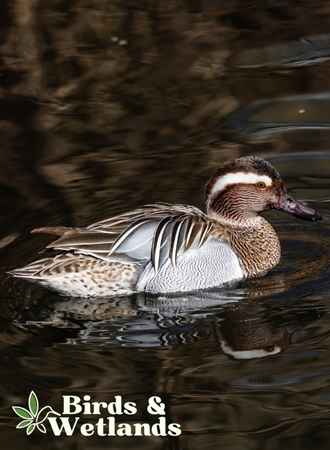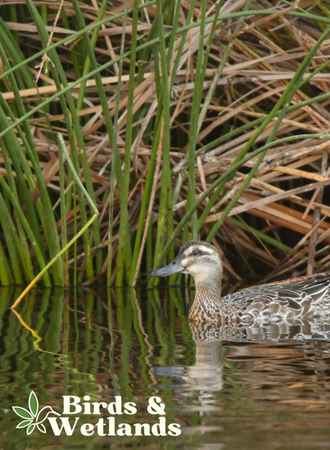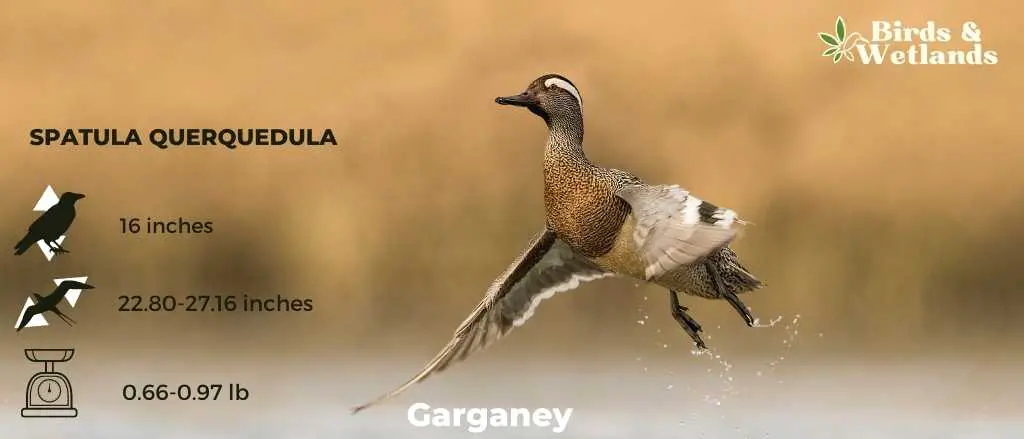The garganey is a small dabbling duck that is found in Europe and the Palearctic. It is a vagrant in North America, where it is sometimes mistaken for the blue-winged teal.
Scientific Name: Spatula querquedula
Height: 41 cm
Wingspan: 58 – 69 cm
Weight: 300- 440 g
Garganey Description
This species was introduced with the binomial name Anas querquedula by Carl Linneus in his 10th edition of Systema Naturae in 1758. It was subsequently moved to the genus Spatula along with ten other species.
The male garganey in breeding plumage is a striking duck with a brown head and breast and a broad white crescent above the eye. The forehead and crown are blackish-brown, while the foreneck is reddish-brown with white flecks.
It has a gray-brown tail, a noticeable green speculum with a white border on the upperwing, pale blue-gray upperwing converts, a dark bill, warm brown eyes and gray legs and feet.
The female garganey shares the same plumage as the male bird but is duller. It also has a distinctive striped facial pattern, pale gray bill, brown eyes, olive-gray legs, and feet.

Listen to Garganey
The garganey makes similar sounds and calls as the blue-winged teal or northern shoveler.
Garganey Habitat
These birds breed in various shallow-water habitats, including shallow ponds, estuaries, tidal flats, swampy meadows, marshes, and lakes with dense and fringing vegetation.
Many flocks of garganeys spend winters in coastal marshes and lagoons. Some birds may venture to areas with fresh and brackish water, reservoirs, rice fields and sewage farms.

Garganey Range
The garganey breeds in the Old World, from Britain and France to Central Europe, with a more continuous population from Eastern Europe into Russia.
In the winter, many birds migrate to Central Africa, India, and Southeast Asia. Some ducks may travel further east to New Guinea.
Additionally, this species is a regular migrant in the Western and Central Aleutian Islands and other Alaskan islands.
Garganey Diet
The diet of the garganey consists of seeds, weeds, roots, tubers, grasses, and aquatic plants. Garganeys also eat insects and invertebrates. The diet of the garganey helps to keep the waterways clean and free of debris.

Garganey Nesting & Mating Habits
The garganey breeds in early April to late May, but months may vary on the range. During the breeding season, it is very territorial.
Like most ducks, the female garganey chooses the nesting site, usually near the water with dense vegetation for cover. She builds the nest in a shallow depression on the ground from leaves and grass. The nest is lined with down feathers.
After mating, she lays between 8 to 11 creamy-white eggs and incubates them for 21 to 23 days. During the incubation period, the male stands nearby.
Garganey Population & Conservation
Due to its extremely large range, the garganey is concerned “Least Concern” and is not included in IUCN red list. However, the overall population trend is decreasing due to habitat loss, hunting pressure and lead poisoning.

Key Points
- The garganey breeds in shallow wetlands with dense aquatic vegetation.
- Females look similar to female teal.
- Males in breeding plumage have a distinct appearance.
- Garganeys migrate in large flocks.
- These birds have a varied diet consisting of plant materials such as seeds, tubers, roots and aquatic plants.

